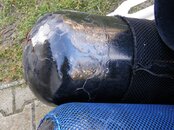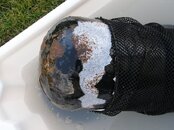I recently accquired four HP steel cylinders that are showing various signs of surface corrosion. I removed the boots and soaked off the salt deposits and noticed some minor surface rust that I would like to address before it spreads any further. All tanks appear to be galvanized but I'm not positive, as I thought that would prevent such corrosion. What should I do to treat/remove the rust and prevent it's recurrence? I've considered naval jelly and some other chemical rust converters but I'm not sure if they are compatible with galvanized surfaces. Maybe sanding and painting? Thanks for the help.
You are using an out of date browser. It may not display this or other websites correctly.
You should upgrade or use an alternative browser.
You should upgrade or use an alternative browser.
Tank rust?
- Thread starter Aceboyd
- Start date
Please register or login
Welcome to ScubaBoard, the world's largest scuba diving community. Registration is not required to read the forums, but we encourage you to join. Joining has its benefits and enables you to participate in the discussions.
Benefits of registering include
- Ability to post and comment on topics and discussions.
- A Free photo gallery to share your dive photos with the world.
- You can make this box go away
lucca brassi
Contributor
Like this two tanks I got them for repair this :
Procedure :
- brushes laminated abrasive disc for SS ( blue colour )
I have repaint tanks with 9 layers of different paints :
- 3 layers of Zn based paint (1,5day dry time)
-2 layers of primary steel paint (1,5day dry time) (not sure but I think it is Pb - lead based )
-4 layers of paint acyril ( spray ) (0,5day dry time) (paint is elastic- and accommodates with temperature of tank )
works fine .
----------------------------------------------------------------------------------
Sanding it is very good thing but - Zn paint must be applied immediately because of water wapour in the air that can cause of micro rust.
Other possibility it is also dust painting which looks fine but:
- tank is thermicaly treated
- powder coating it is very hard and compact but if brokes (special at filling tanks where they become relative hot and colour stay cold ) , salt water can penetrate under coating armour and make great disaster .
Procedure :
- brushes laminated abrasive disc for SS ( blue colour )
I have repaint tanks with 9 layers of different paints :
- 3 layers of Zn based paint (1,5day dry time)
-2 layers of primary steel paint (1,5day dry time) (not sure but I think it is Pb - lead based )
-4 layers of paint acyril ( spray ) (0,5day dry time) (paint is elastic- and accommodates with temperature of tank )
works fine .
----------------------------------------------------------------------------------
Sanding it is very good thing but - Zn paint must be applied immediately because of water wapour in the air that can cause of micro rust.
Other possibility it is also dust painting which looks fine but:
- tank is thermicaly treated
- powder coating it is very hard and compact but if brokes (special at filling tanks where they become relative hot and colour stay cold ) , salt water can penetrate under coating armour and make great disaster .
Attachments
Tanks should not get hot enough to make paint fail when filling. However they will measurably expand and contract with each use cycle.
Remove the rust (lightly sandblasting) then apply cold galvanize primer followed by finish coats.
Pete
Remove the rust (lightly sandblasting) then apply cold galvanize primer followed by finish coats.
Pete
I have access to a bead blast cabinet, If I can fit a HP 120 inside. I assume the glass beads would be sifficient to remove the rust. Is cold galvanize primer something I can pick up at the local home center? Also, what would be a suitable finish paint that would withstand the aforementioned heating and cooling and more importantly, the expansion and subsequent contraction? Acrylic, alkyd, enamel, polyurethane?
DennisW
Contributor
Never powder coat your tanks. The heat that it takes to powder coat a tank will cause it to lose the strength due to the temper given to the steel at the manufacturer. If you powder coat your tank, you will not get a good shop to perform a visual inspection on the tank. And the next time you take it for Hydrostatic testing, they will condemn the tank immediately. You cannot powder coat Al tanks either.
lucca brassi
Contributor
Agree. I want to warn on powder coating !
Another problem is tanks pressure certification with put- in iron date and certificate number .
-----------------------------------------------------------------------------------------
yes - be attentive on high procent of Zn in colour ( paint is very heavy)
acrylic paint is OK
( polyurethane paint is better because of abrasion resistance but it needs proffessional care by painting because of 2 components mixture but this is ''cold'' way of powder coating because chemicals are the same )
Another problem is tanks pressure certification with put- in iron date and certificate number .
-----------------------------------------------------------------------------------------
Is cold galvanize primer something I can pick up at the local home center?
yes - be attentive on high procent of Zn in colour ( paint is very heavy)
acrylic paint is OK
( polyurethane paint is better because of abrasion resistance but it needs proffessional care by painting because of 2 components mixture but this is ''cold'' way of powder coating because chemicals are the same )
halocline
Contributor
Try a product called ZRC galvilite cold galvanizing compound. It comes in spray cans or quarts.
Gilldiver
Contributor
Never powder coat your tanks. The heat that it takes to powder coat a tank will cause it to lose the strength due to the temper given to the steel at the manufacturer. If you powder coat your tank, you will not get a good shop to perform a visual inspection on the tank. And the next time you take it for Hydrostatic testing, they will condemn the tank immediately. You cannot powder coat Al tanks either.
Annealing temps of STEELs are well above those used for powder coating (250-350F). So, powder coating of steel tanks is not a metals concern.
But the annealing and ageing temps of ALUMINUM's are within the temps used for powder coating so powder coating of aluminum will most likely cause a strength loss and should NEVER be done on any ALUMINUM under pressure or a fatigue load.
That is the answer from a metals guy, Of course your LDS may have a different opinion and refuse to fill any tank with a powder coating.
Similar threads
- Replies
- 33
- Views
- 3,926
- Replies
- 14
- Views
- 1,708
- Replies
- 2
- Views
- 1,039
- Replies
- 15
- Views
- 1,872
- Replies
- 2
- Views
- 908






